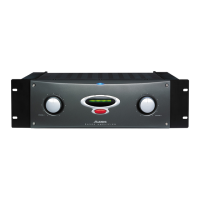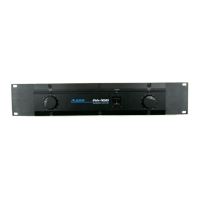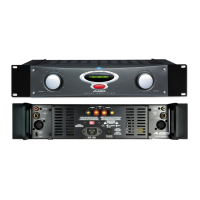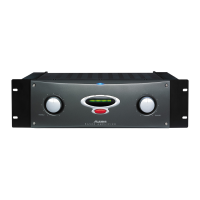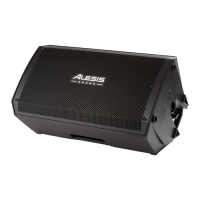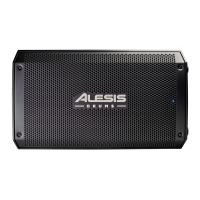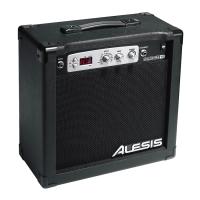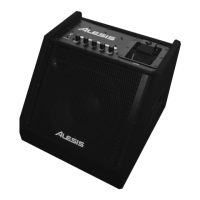Do you have a question about the Alesis RA-100 and is the answer not in the manual?
Overview of the RA-100 amplifier, its design, and suitability for digital audio applications.
Instructions for checking the amplifier's shipping carton and contents for any transit damage.
Explains the manual's logical structure and provides general advice on handling the amplifier.
Diagram and explanation of the RA-100's rear panel components and their functions.
Details on fuse type, AC cord usage, and electrical service requirements for safe operation.
Guidance on rack mounting, shelf placement, and avoiding electromagnetic interference for optimal performance.
Recommendations to prevent magnetic fields from affecting the amplifier or its connected equipment.
Details on input jack characteristics, cable types, and wiring conventions for connecting sources.
Advice on selecting and wiring audio cables, including precautions for connection and disconnection.
Methods for connecting balanced line sources to the RA-100's unbalanced inputs.
Information on speaker output connector options (phone jack, push clip) and cable types.
Step-by-step guide on how to connect speaker wires to the RA-100's push connectors.
Explanation of speaker cone movement and its effect on sound quality and phase coherence.
Description of front panel controls including volume, power, mute, and clip indicators.
Method for testing speaker polarity using a battery and observing cone movement.
Guidance on selecting speakers that match the RA-100's power output and performance characteristics.
Explanation of ground loops, their causes, and methods to prevent hum or buzz in audio systems.
Using the RA-100 to drive near-field reference speakers in studio environments.
Application of the RA-100 for auditorium and live music, driving club speaker systems.
Connecting keyboards and effects processors to the RA-100 for amplification.
System setup for guitarists using rack-mount effects and the RA-100 for amplification.
Using two RA-100 units for biamplification, driving separate low and high frequency speaker systems.
Guidelines for cleaning, general maintenance, and when to refer servicing to qualified technicians.
Troubleshooting steps to identify and resolve hum issues originating from the unit or input sources.
Steps to diagnose and fix problems where no audio output is heard from the speakers.
Addressing issues of distorted or low-level audio, potentially related to thermal protection or cabling.
Diagnosing thin sound or unpredictable audio behavior, often linked to speaker polarity issues.
Overview of the RA-100 amplifier, its design, and suitability for digital audio applications.
Instructions for checking the amplifier's shipping carton and contents for any transit damage.
Explains the manual's logical structure and provides general advice on handling the amplifier.
Diagram and explanation of the RA-100's rear panel components and their functions.
Details on fuse type, AC cord usage, and electrical service requirements for safe operation.
Guidance on rack mounting, shelf placement, and avoiding electromagnetic interference for optimal performance.
Recommendations to prevent magnetic fields from affecting the amplifier or its connected equipment.
Details on input jack characteristics, cable types, and wiring conventions for connecting sources.
Advice on selecting and wiring audio cables, including precautions for connection and disconnection.
Methods for connecting balanced line sources to the RA-100's unbalanced inputs.
Information on speaker output connector options (phone jack, push clip) and cable types.
Step-by-step guide on how to connect speaker wires to the RA-100's push connectors.
Explanation of speaker cone movement and its effect on sound quality and phase coherence.
Description of front panel controls including volume, power, mute, and clip indicators.
Method for testing speaker polarity using a battery and observing cone movement.
Guidance on selecting speakers that match the RA-100's power output and performance characteristics.
Explanation of ground loops, their causes, and methods to prevent hum or buzz in audio systems.
Using the RA-100 to drive near-field reference speakers in studio environments.
Application of the RA-100 for auditorium and live music, driving club speaker systems.
Connecting keyboards and effects processors to the RA-100 for amplification.
System setup for guitarists using rack-mount effects and the RA-100 for amplification.
Using two RA-100 units for biamplification, driving separate low and high frequency speaker systems.
Guidelines for cleaning, general maintenance, and when to refer servicing to qualified technicians.
Troubleshooting steps to identify and resolve hum issues originating from the unit or input sources.
Steps to diagnose and fix problems where no audio output is heard from the speakers.
Addressing issues of distorted or low-level audio, potentially related to thermal protection or cabling.
Diagnosing thin sound or unpredictable audio behavior, often linked to speaker polarity issues.
| Input Impedance | 20 kOhms |
|---|---|
| Type | Stereo Power Amplifier |
| Channels | 2 |
| Outputs | Binding posts |
| Frequency Response | 20Hz - 20kHz |
| Dimensions | 19" x 3.5" x 10" |
| Inputs | 2 x 1/4" TRS |
